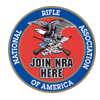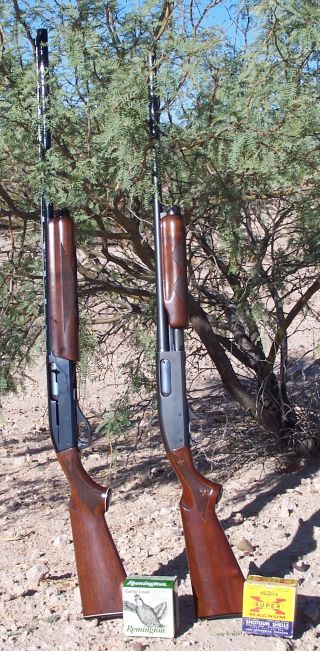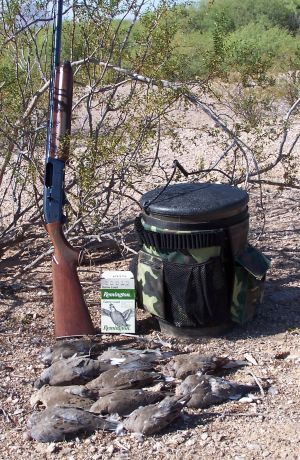
| Articles | Documents | Equipment | Events | Links | Membership | Miscellaneous | Scrapbook | Targets | What's New |
|
The Return of the 16 Gauge?
| September 2004 | ||||
| Dan Martinez
| |||||
|
When I was a lad, my Dad, much more a dedicated trout
fisherman than he was a hunter, owned only three hunting tools: a
45 pound draw weight recurve bow, a sporterized 1903 Springfield in
.30-06 (naturally), and a Remington Wingmaster in 16 gauge. I think
he sold off the Springfield when I was in my teens, but I am now the
owner of his Red Wing recurve and his Wingmaster. Iíve recently
found a Springfield thatís a spittiní image of his old one, but thatís
a story for another time.
I keep telling you guys that I started hunting much later in life than
most hunters. I used Dadís Wingmaster to take my very first wild game
on the opening day of dove season in 1993. Hunting with co-workers
Brad Birdsell and Mike Hodge at Powers Butte down near Buckeye, I
knocked only 3 doves out of the sky that day. But I won the contest
for style points when I caught my last bird of the day, an incomer, in
my hand before it hit the ground! Yes, in front of witnesses!
Iíve dallied with other shotguns over the years, several have come and
gone. I played a little at the sporting clays game for awhile, only
attaining C class status though. The closest Iíve come to owning a real
sporting clays gun, was a couple of over/unders. I owned and loved a
trim and lightweight Marocchi Avanza in 20 gauge for a couple of years.
I got pretty deadly with that little gun. Up until this season, my
only full limit of 10 doves was taken with the Avanza. It always had
some nagging little mechanical problems though. I decided that it had
to go when I snapped the breech closed one day, and it fired! I was
safely pointed at the ground, so no harm done, but to me, that was an
unforgivable sin. Bye bye Avanza.
Then I picked up a Beretta over/under in 12 gauge. I had drooled over
Beretta O/Us for many years never thinking that I could afford one,
when a large local sporting goods store decided to go out of business
and was selling off stock at deep discounts. It was the plain-jane
Beretta, the ďEssentialĒ, but still, it was all Beretta. I wasnít
quite as deadly with that Italian stallion, as I was with the Avanza,
but it served me well for a number of years.
The big problem I had with the Beretta was that it hurt me! As the
cheapest in the line, the Essential had no recoil pad, just a plastic
butt plate. But it wasnít my shoulder that was complaining, it was
my cheekbone. I tried to solve the problem with a stick-on comb pad,
and that certainly helped, but it didnít fix the problem. By the end
of a regulation 100 bird sporting clays shoot, my cheek was in so much
pain, that if I hit any of my last 20 birds, it was pure luck.
Thatís when I first started thinking seriously about going back to a
good old Remington repeater, but an autoloader, as my designated
sporting clays gun. Dadís old Wingmaster always seemed to fit me just
right. When I bring the butt of the Wingmaster into my shoulder, my
eye is naturally looking straight over the barrel. No need to mash my
cheek into the comb of the stock to get a good view. Thereís just
something right about the way a Remington fits me.
Fortunately, I was able to get every penny out of the Beretta that I
had into it. My immediate replacement for the Beretta was yet another
Italian! Ė but a pump gun. I brought home a Benelli Nova. Though it
only has a 24Ē barrel, since itís a 3ĹĒ chambered 12 gauge, and
because of its unique plastic overmolded construction, itís still a
big, thick gun.
Itís primary purpose in my stable was for waterfowl and turkey hunting.
Not long after bringing it home, I took it out one Thursday evening to
the Ben Avery trap fields to see what it could do. Picture this: the
gun is covered muzzle to toe in green camoflage, itís a pump, and I
show up in jeans and a t-shirt. So basically, I look like Average
Hunter Joe. I take the field next to a guy with a fine Belgian Browning
Superposed. Heís nattily attired in slacks and an expensive shotgun
vest. I swear I heard the guy sniff as I walked up to the line. Long
story short, I hit 24 out of 25, my best-ever trap score. He hit 19 or
so. He looked at me a little differently after the set than he had
regarded me before.
Sporting clays requires a quick second shot, but itís so easy to
short-stroke a pump and jam up the gun. After I got rid of the
over/unders, the most suitable shotgun for sporting clays left in
my armory was another Remington, a Model 1100 LT-20 autoloader. I
bought it for my wife, hoping to get her interested in shotgunning,
but it didnít work. Sheís never fired it. But itís a beautiful
little gun that I could never see parting with. Iíve taken a number
of dove with it, and Iíve shot it in competition in HSC club shoots
and in 100 bird official sporting clays shoots. But I can never get
away from the feeling that Iím giving away too much by shooting a 20
gauge against 12 gauge competitors. Now my youngest son Sammy has
latched onto it as his favorite dove and clays gun. Iím afraid I
wonít get to shoot it much anymore!
So basically thatís where Iíve stood with shotguns for the past
couple of years: That big fat pickup truck of a shotgun, the
Benelli Nova, the delightfully trim Remington 1100 20 gauge, or
Dadís old 16 gauge Wingmaster. These three will certainly carry
the water for any type of Arizona bird hunting imaginable. Still,
none was especially suitable for the sporting clays game.
In 2002, Remington decided to finally bring the 16 gauge back to
the model 870 lineup in four variations. Remington discontinued
the 16 gauge back in the late seventies. Since I have such a soft
spot for the 16, I was naturally delighted, though at the same time
disappointed that I couldnít do my part to assure Remington that they
made a good move. I already had mine!
I really donít know when Dadís Wingmaster was made. Iím pretty sure
it dates from around the mid-1960ís. There were no choke tubes back
then. Dadís came with a full choked 28Ē plain barrel. When it became
mine, I made a couple of changes. First, I replaced the buttstock. I
donít know if Dad had it done, or if he got it that way, but it had a
youth-sized buttstock on it. I easily found a used standard-length
Remington 870 walnut buttstock at the gun show. Remingtonís 16s are
not made on a special 16-gauge frame size. They share the same frame
with the 12 gauges.
Then I sent the Wingmasterís barrel off to Briley in Texas to have a
couple of inches chopped off, and to have a choke tube system installed.
While full-choked, the gun was essentially useless to me. I see the
role of the 16 gauge as a perfect upland bird gun. I specified that
Briley send it back to me with cylinder, improved cylinder, and modified
chokes Ė no full.
Then last year, 2003, Remington announced that they were also bringing
back the 16 gauge Model 1100. For various reasons, I didnít jump on it
last year, but this year, for various other reasons, I decided that now
was the time to buy myself a birthday present.
My birthday happens to coincide with the opening of dove season. Since
I was not drawn for any Arizona big game hunts, I had already decided
that this was going to be a big bird hunting year for me. My little
brother came out from Florida for a visit this summer and was amazed
at how many doves he saw flying around here. And there have been many
bunnies and some large coveys of quail in my neighborhood, several times
hanging out in my front yard! Apparently, the timing of the winter and
spring rains has been very good to the small game populations this year.
The experts say that thereís somewhat of a magical relationship between
shot column width and height in a 16 gauge. This has to do with the
standard 1 oz. to 1ľ oz. bird load for the 16 gauge having ďsquareĒ
dimensions Ė just as high as it is wide. This is supposed to create
in the 16 gauge, an unsurpassed, evenly distributed shot pattern.
Think back a moment to the definition of shotgun gauge Ė itís the number
of pure lead balls of the gunís bore diameter needed to equal one pound.
Therefore, the theoretical 16 gauge bore sized lead ball weighs exactly
one ounce Ė since there are 16 ounces to the pound.
Well, I donít know how true this theory about perfect shot patterns
really is. All I know is that I like the gauge, and I figured that
a 16 gauge Remington 1100 would be the perfect medicine both for
upland bird hunting and for sporting clays up to the level of my
modest abilities. I expect that the Remington stock shape and the
reduced level of recoil due to the smaller standard pellet charge
and the autoloading action would be kind to both my shoulder and to
my cheek bone over the course of 100 clays.
So I went down to Sportsmanís Warehouse and placed my special order
for a 16 gauge Model 1100. Of course I expected that I would have
to have it ordered. What surprised me was that Sportsmanís Warehouse
doesnít normally stock any variation of the Model 1100. They
seem to otherwise have a pretty good selection of shotguns.
My new Remington arrived in less than a week. There is only one
variation of the Model 1100 in 16 gauge. Remington calls it the
ďClassic FieldĒ. None of this matte finish, black synthetic stock
crap. The metal work is highly polished blue and the furniture is
semi-gloss American walnut. White line spacers set off both the grip
cap and the solid plastic buttplate. There is no rolled-in
pseudo-engraving on the metal, only the words ďClassic FieldĒ in a
script-type font. The barrel sports a vent rib and choke tubes, both
of which were not available the last time Remington cataloged a 16
gauge Model 1100.
Yes, it is built on the 12 gauge Model 1100 frame size. Many shotgun
pundits will argue that a 16 gauge isnít worth doing if itís nothing
more than a down-bored 12 gauge. A 16 gauge built on a specifically
downsized frame will be lighter and livelier than one created from a
12 gauge. Well, thatís a certainty. For this individual, that was
less of a consideration.
Two barrel lengths are offered for the 16 gauge Classic Field, 26 and
28 inches. I opted for the 28 inch which is specíed at 7ľ pounds. I
was disappointed though, when my specimen weighed-in a whole pound more
at 8ľ pounds. On the other hand, its better to soak up the recoil over
a long day of sporting clays. Though heavier, itís still slimmer and
trimmer than my workhorse Benelli 12 gauge.
This would be Samís third year as a shooter, and Benís first year.
Sam was shooting the LT-20, and Ben was shooting his Mossberg 20 gauge
Model 500. You know what I was shooting.
Ben knocked two out the air this year, and Sam made a new personal best
of five Ė a half limit. As for myself, for only the second time in my
hunting career, I got a full limit of 10 birds with my new Classic Field.
Alright, Iíll admit that I wasnít able to do it within only one box of
25 Ė I had to dip into a second box. Nevertheless, I think the new gun
acquitted itself quite admirably in the field.
The title of this piece is a question for good reason. Apparently
Remington believes enough in the Return of the 16 Gauge to have
re-introduced five model variations in the last couple of years.
Also today, 16 gauge shotguns are available from a number of makers
of imported break action guns. The loads available may have dwindled
over the years, but today they have reached a steady state Ė no recent
introductions, but no recent discontinuations either. So the fate of
the 16 gauge rests in your hands, my fellow sportsmen. Iíve done my
part to help keep the noble 16 gauge alive and well in the 21st century.
| |||||
| If you enjoyed this story, or found it useful, please consider clicking here to join the NRA at a discount of $15 off the normal membership cost. You will be supporting both this website and adding your voice in support of the Second Amendment. Thank you very much. |

|

|
|

